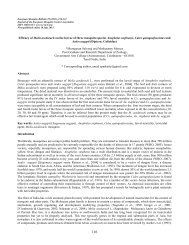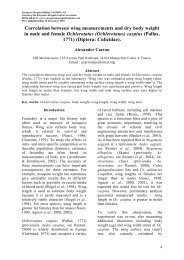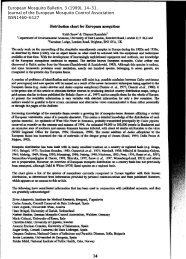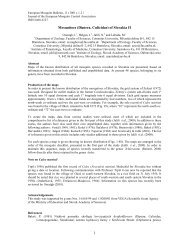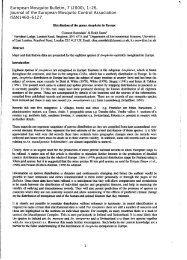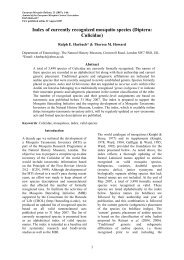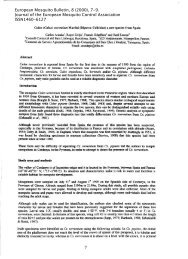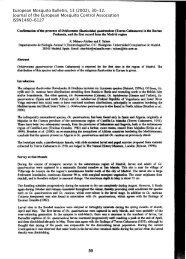Diptera, Culicidae, Aedes - European Mosquito Bulletin Journal of ...
Diptera, Culicidae, Aedes - European Mosquito Bulletin Journal of ...
Diptera, Culicidae, Aedes - European Mosquito Bulletin Journal of ...
Create successful ePaper yourself
Turn your PDF publications into a flip-book with our unique Google optimized e-Paper software.
<strong>European</strong> <strong>Mosquito</strong> <strong>Bulletin</strong>, 16 (2003), 22-26<strong>Journal</strong> <strong>of</strong> the <strong>European</strong> <strong>Mosquito</strong> Control AssociationISSN1460-6127Table 1. Mean lengths (mm) <strong>of</strong> the gonocoxite, medial (M) and lateral (L) arms <strong>of</strong> the gonostylus <strong>of</strong> Ae. rossicus,Ae. esoensis, Ae. cinereus and Ae. geminus.Gonocoxite M L M/Lrossicus 0.55(0.54-0.58) 0.13(0.12-0.14) 0.21(0.20-0.22) 0.64(0.60-0.68)n=16 n=20 n=20 n=20esoensis 0.45(0.41-0.49) 0.09(0.08-0.10) 0.19(0.18-0.20) 0.46 (0.42-0.47)n=9 n=18 n=18 n=18cinereus 0.46(0.43-0.49) 0.11(0.10-0.11) 0.19(0.18-0.20) 0.58 (0.56-0.61)n=14 n=10 n=10 n=10geminus 0.49(0.45-0.50) 0.11(0.10-0.12) 0.20(0.19-0.21) 0.56 (0.50-0.60)n=13 n=17 n=17 n=17Table 2. Mean number <strong>of</strong> setae on medial and lateral branches <strong>of</strong> the claspette <strong>of</strong> Ae. rossicus, Ae. esoensis, Ae.cinereus and Ae. geminus.Medial branchLateral branchrossicus 4.2 (3-5) n=36 2.5 (1-5) n=36esoensis 3.2 (2-4) n=14 absentcinereus 3.1 (3-4) n=14 3.3 (2-5) n=14geminus 2.9 (2-4) n=61 3.2 (1-7) n=62Individual variabilityAll <strong>of</strong> the described features <strong>of</strong> Ae. rossicus, Ae. cinereus and Ae. geminus are stable for each species throughout theirdistribution in Russia. The greatest variation is in the claspettes <strong>of</strong> species <strong>of</strong> subgenus <strong>Aedes</strong>, especially Ae. rossicus.Nevertheless the structure <strong>of</strong> the claspette is a reliable feature for diagnosing the species. The descriptions and theillustrations <strong>of</strong> Ae. rossicus, Ae. cinereus, Ae. geminus from Europe (Natvig, 1948; Peus, 1970, 1972; Labuda, 1977)testify to the stability <strong>of</strong> the diagnostic features.Our data on individual variation <strong>of</strong> Ae. esoensis are available only from Sakhalin Island. However the descriptions <strong>of</strong>Ae. esoensis from Maritime Territory (Stackelberg, 1927; Gutsevich et al., 1970) and from Japan (Tonaka et al., 1975,1979) show stability <strong>of</strong> described morphological features <strong>of</strong> this species.Distributions <strong>of</strong> Ae. cinereus, Ae. geminus, Ae. rossicus and Ae. esoensis in Russia and the Palaearctic<strong>Aedes</strong> cinereusMore detailed information is required regarding the distribution <strong>of</strong> Ae. cinereus because Ae. yamadai, Ae. sasai, Ae.dahuricus and Ae. geminus were earlier synonymised with Ae. cinereus. Furthermore the illustrations <strong>of</strong> the dististyle(= gonostylus) and claspette variation in forms regarded by Lvov (1956) as intermediate between Ae. cinereus and Ae.esoensis agree closely with features <strong>of</strong> Ae. sasai (Tonaka et al., 1979). However there is no doubt that in Russia Ae.cinereus is distributed from the <strong>European</strong> borders to the far east (Gutsevich et al., 1970).24



